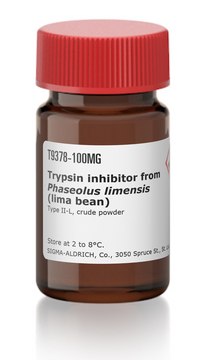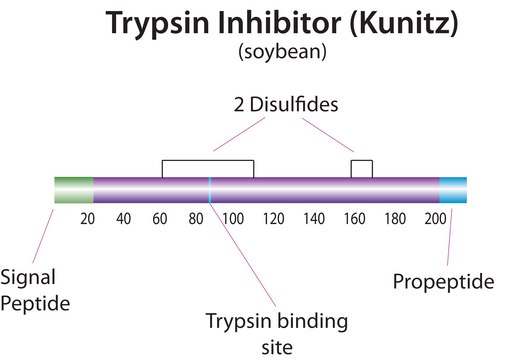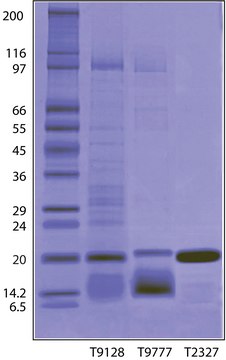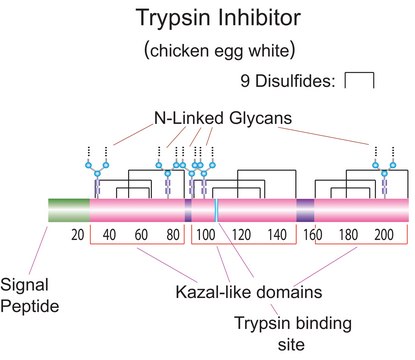T1021
Trypsin inhibitor
powder, suitable for isoelectric focusing (IEF)
Synonym(s):
SBTI
About This Item
Recommended Products
Product Name
Trypsin inhibitor from Glycine max (soybean), Isoelectric focusing marker, pI 4.6
biological source
Glycine max (soybean)
Quality Level
form
powder
mol wt
20,100 Da
technique(s)
isoelectric focusing (IEF): suitable
pI
4.6
solubility
balanced salt solution: 1 mg/mL
concentrate: >10 mg/mL, hazy, amber-yellow
phosphate buffer: 10 mg/mL
water: 10 mg/mL
serum-free medium: soluble
shipped in
ambient
storage temp.
−20°C
Looking for similar products? Visit Product Comparison Guide
Biochem/physiol Actions
Components
Unit Definition
Preparation Note
Solutions can retain activity when stored short-term at 2-8° C. Solutions are stable in frozen aliquots at -20°C.
Application
related product
Regulatory Information
Choose from one of the most recent versions:
Certificates of Analysis (COA)
Don't see the Right Version?
If you require a particular version, you can look up a specific certificate by the Lot or Batch number.
Already Own This Product?
Find documentation for the products that you have recently purchased in the Document Library.
Which document(s) contains shelf-life or expiration date information for a given product?
If available for a given product, the recommended re-test date or the expiration date can be found on the Certificate of Analysis.
How do I get lot-specific information or a Certificate of Analysis?
The lot specific COA document can be found by entering the lot number above under the "Documents" section.
How do I find price and availability?
There are several ways to find pricing and availability for our products. Once you log onto our website, you will find the price and availability displayed on the product detail page. You can contact any of our Customer Sales and Service offices to receive a quote. USA customers: 1-800-325-3010 or view local office numbers.
What is the Department of Transportation shipping information for this product?
Transportation information can be found in Section 14 of the product's (M)SDS.To access the shipping information for this material, use the link on the product detail page for the product.
What is the molecular weight and amino acid sequence of trypsin inhibitor from Glycine max (soybean)?
Soybean trypsin inhibitor is a mixture of the three types. We have not characterized our trypsin inhibitor products in terms of how much of each of the three types may be present. All three have a molecular weight of between 20,000 and 20,200 daltons, so one might use 20,100 daltons as an average.The three types vary in the amino acids at a few positions. The detailed summary of the three types (or variants) was published in the following linked reference: J. Biochem. (Japan), 98, 435-448 (1985).Note that the authors use Tia, Tib and Tic to indicate the three variants.
My question is not addressed here, how can I contact Technical Service for assistance?
Ask a Scientist here.
Protocols
Natural trypsin inhibitors (serpins) regulate protein activation and catabolism by inhibiting serine proteases in vivo.
Chromatograms
application for HPLCOur team of scientists has experience in all areas of research including Life Science, Material Science, Chemical Synthesis, Chromatography, Analytical and many others.
Contact Technical Service




